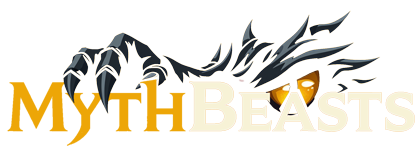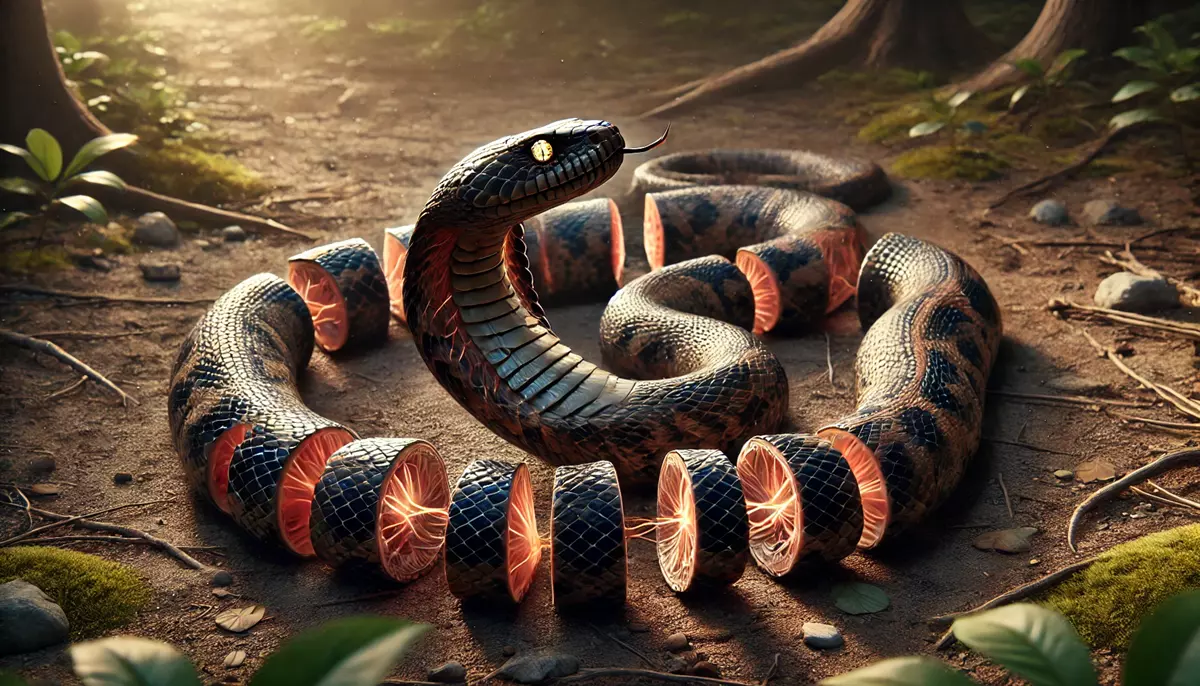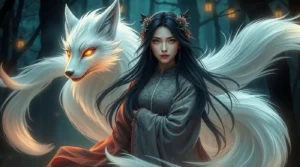Introduction
The Chinese dragon, or lóng (龙), is one of the most revered and powerful mythical creatures in Chinese culture. Unlike the fire-breathing, destructive dragons of Western folklore, the Chinese dragon represents wisdom, strength, and prosperity. It is a celestial being, often linked to emperors, rivers, and the heavens.
Legends describe the Chinese dragon as a benevolent force, responsible for controlling water, summoning rain, and ensuring balance in the cosmos. It is deeply rooted in ancient beliefs, appearing in folklore, religious practices, and imperial symbolism. The dragon was the exclusive emblem of the emperor, reinforcing the idea that rulers had divine authority over the land.
Throughout history, the dragon’s form has evolved, combining features from various animals to create a majestic, serpentine figure with the power to soar through the sky. Today, it remains an essential symbol in Chinese festivals, art, and traditions, symbolizing luck, protection, and success.
History/Origin
The origins of the Chinese dragon stretch back over 7,000 years, appearing in early Neolithic cultures across China. Some of the earliest depictions of dragons have been found in the Hongshan Culture (4700–2900 BCE), where jade artifacts shaped like dragons suggest their sacred status. Similar dragon motifs appear in the Liangzhu Culture (3400–2250 BCE), demonstrating how deeply embedded the dragon was in ancient Chinese belief systems.

By the time of the Shang Dynasty (1600–1046 BCE), dragons were linked to rain-making rituals and agricultural prosperity. The early Chinese saw dragons as heavenly creatures that controlled rainfall and rivers, essential for sustaining life. Oracle bones from this period mention dragons in the context of divination and communication with spirits, further solidifying their role as supernatural beings.
The Zhou Dynasty (1046–256 BCE) continued the dragon’s integration into spiritual and political life. Emperors were said to be “sons of the dragon,” reinforcing their divine mandate to rule. This belief reached its peak during the Han Dynasty (206 BCE–220 CE), where dragons became the ultimate imperial symbol, appearing on robes, flags, and palace architecture.
“The dragon rises with the wind and descends with the rain, controlling the cycles of heaven and earth.” (Shang Dynasty Oracle Bone Script)
By the time of the Tang (618–907 CE) and Song Dynasties (960–1279 CE), the Chinese dragon had fully developed into its iconic serpentine form, with long whiskers, antlers, and the ability to fly without wings. The imperial connection remained strong, with only the emperor permitted to use the five-clawed dragon as an emblem, while lesser nobles and officials used dragons with fewer claws.
Today, remnants of these beliefs survive in festivals such as the Dragon Boat Festival, which honors Qu Yuan, a revered poet and minister. The dragon remains a guardian of prosperity and balance, a stark contrast to the monstrous depictions of dragons in Western myths.
Name Meaning
The Chinese word for dragon, 龙 (lóng), carries profound symbolic meaning. Unlike its Western counterpart, which often represents destruction, the Chinese dragon embodies wisdom, longevity, and cosmic harmony.
The character 龙 evolved from ancient scripts, including oracle bone script (甲骨文) and bronze inscriptions (金文). These early forms depicted a coiling serpent-like figure, reflecting the dragon’s long, sinuous shape. Over time, the term “lóng” came to represent excellence, strength, and transformation.
One of the most well-known idioms featuring “lóng” is “望子成龙” (wàng zǐ chéng lóng), meaning “hope one’s son becomes a dragon.” This phrase highlights how deeply embedded dragons are in Chinese thought, symbolizing aspiration, success, and personal greatness.
Additionally, the term “龙脉” (lóng mài), meaning “dragon veins,” refers to the belief that mountains and rivers follow the natural flow of energy, much like a dragon’s winding form. This concept is crucial in feng shui, where the balance of energy (qi) determines good fortune.
“The dragon soars in the sky, its presence a sign of prosperity and the favor of heaven.” (Zhou Dynasty Texts)
Appearance
The Chinese dragon has a distinctive and elaborate appearance, combining features from multiple animals to create a majestic and otherworldly form. Unlike the winged, fire-breathing dragons of European myths, the Chinese dragon is long and serpentine, typically covered in scales.
Its physical traits are traditionally said to be a combination of nine different animals:
- Head of a camel – Symbolizing resilience
- Horns of a deer – Representing grace
- Eyes of a demon – Signifying supernatural power
- Ears of an ox – Indicating attentiveness
- Neck of a snake – Representing flexibility
- Belly of a clam – Symbolizing mystery
- Scales of a carp – Representing transformation
- Claws of an eagle – Indicating strength
- Paws of a tiger – Symbolizing authority
These attributes reflect the dragon’s supreme power over nature, making it a creature of divine balance and cosmic harmony. Its ability to fly without wings reinforces its spiritual connection to heaven and the elements.
Chinese dragons often appear in different colors, each carrying its own symbolism:
- Gold Dragons – Power and imperial authority
- Blue & Green Dragons – Nature, growth, and health
- Red Dragons – Vitality and good fortune
- Black Dragons – Destructive forces, often linked to storms
- White Dragons – Mourning and death
The number of claws also indicates status. Five-clawed dragons were exclusively for emperors, while four-clawed and three-clawed dragons were used by nobles and lower-ranking officials. This system was strictly enforced, reinforcing the dragon’s association with imperial rule.
“The golden dragon coils above the mountains, its breath bringing rain to the lands and life to the people.” (Tang Dynasty Poetry)
Famous Folklore Stories
The Four Dragon Kings
In ancient Chinese mythology, the Four Dragon Kings, Ao Guang (East Sea), Ao Qin (South Sea), Ao Run (West Sea), and Ao Shun (North Sea), were tasked with governing the seas and dispensing rain to the mortal world. According to legend, during a severe drought, the Dragon Kings observed the suffering of the people and decided to intervene. They ascended to the heavens to plead with the Jade Emperor for rain.
“The dragons, seeing the suffering of the people, could not remain idle. They resolved to act, even against the will of the Jade Emperor.” (The Chinese Fairy Book, Richard Wilhelm, 1921)
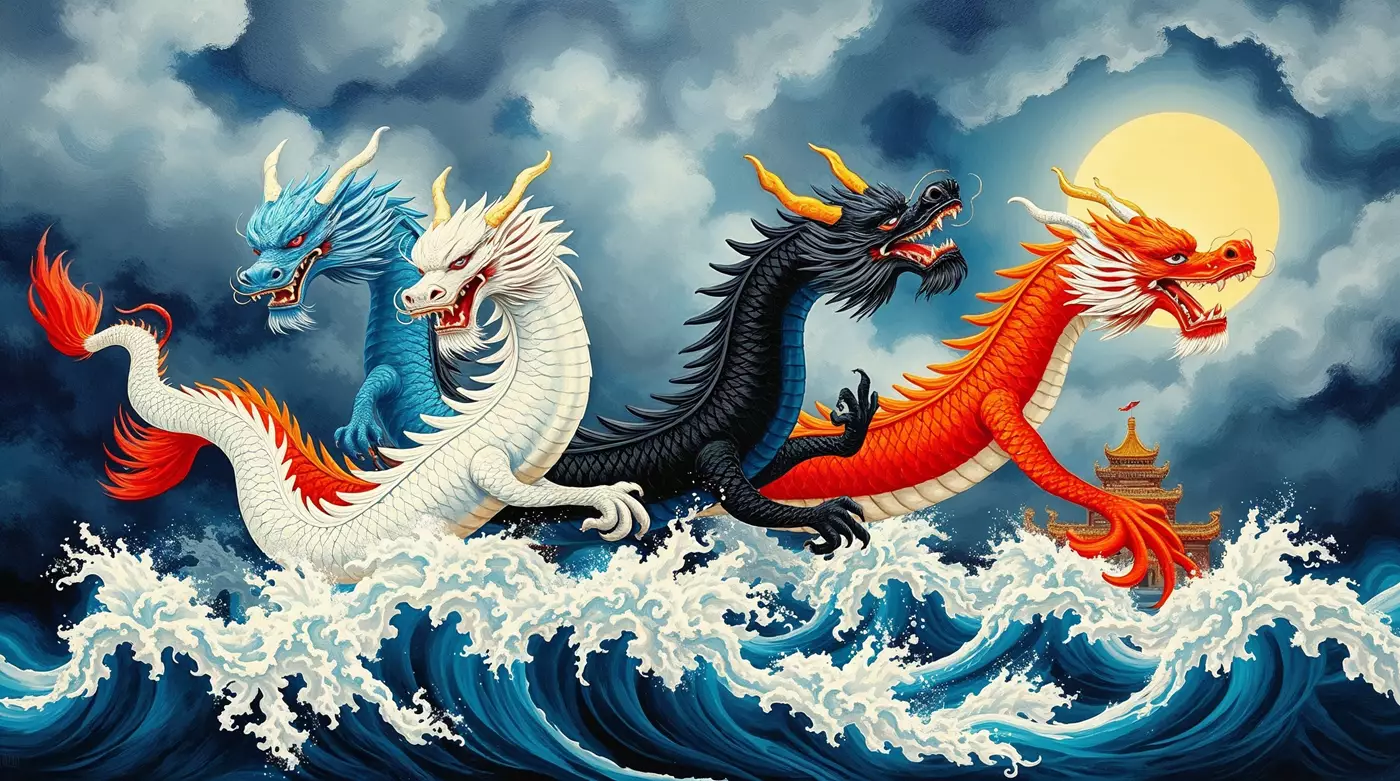
When their pleas were ignored, the Dragon Kings took matters into their own hands. They drew water from the sea and sprayed it across the land, bringing much-needed relief. Enraged by their defiance, the Jade Emperor imprisoned each dragon under a mountain, where they transformed into the four great rivers of China: the Yangtze, Yellow, Pearl, and Heilongjiang Rivers. This tale underscores the dragons’ benevolence and their sacrifice for humanity.
Liu Yi and the Dragon Princess
During the Tang Dynasty, a scholar named Liu Yi encountered a shepherdess weeping by a river. She revealed herself as the daughter of the Dragon King of Lake Dongting, forced into marriage with a cruel husband in the Jing River. Unable to escape, she sought someone to deliver a letter to her father. Moved by her plight, Liu Yi agreed to help.
“Liu Yi took the letter, vowing to deliver it to the Dragon King, unaware of the extraordinary journey that awaited him.” (The Dragon King’s Daughter: Ten Tang Dynasty Stories, Translated by Yang Hsien-yi and Gladys Yang, 1954)

Upon delivering the message, the Dragon King was grateful and offered Liu Yi treasures, which he declined. Instead, the Dragon King arranged for his daughter’s freedom and later, with her consent, her marriage to Liu Yi. This story highlights themes of compassion, duty, and the intertwining of human and dragon realms.
The Dragon’s Pearl
A fisherman discovered a luminous pearl that brought prosperity to his village. Unbeknownst to him, the pearl belonged to a dragon residing in a nearby river. The dragon, seeking the return of its treasure, transformed into a beggar and approached the fisherman. However, the villagers, enamored by their newfound wealth, refused to relinquish the pearl.
“The dragon, in disguise, pleaded for the return of its pearl, but greed had clouded the hearts of the villagers.” (The Chinese Dragon, L. Newton Hayes, 1922)
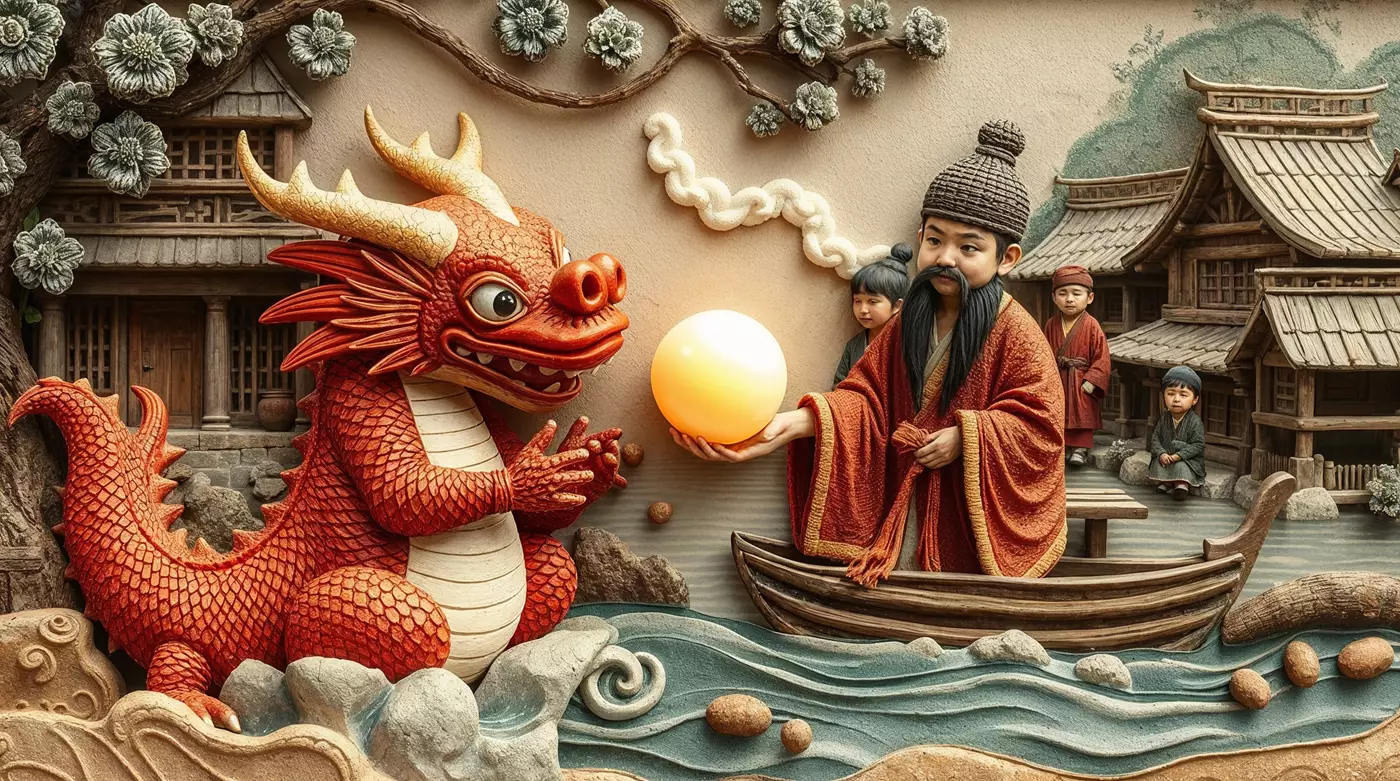
In response, the dragon unleashed floods upon the village, reclaiming the pearl amidst the chaos. This tale serves as a cautionary reminder of the perils of greed and the importance of respecting the possessions of others, even those of mythical beings.
Cultural Impact
The Chinese dragon, or lóng (龙), holds a profound place in Chinese culture, symbolizing power, strength, and good fortune. Historically, it has been associated with the emperor, representing imperial authority and divine right. Emperors adorned their robes with dragon motifs, and the creature featured prominently in architecture and art. In modern times, the dragon remains a potent emblem during celebrations like the Chinese New Year, where dragon dances are performed to usher in prosperity and ward off evil spirits. The dragon’s image is also prevalent in business and branding, symbolizing success and ambition. Its enduring presence reflects the deep-seated cultural values and beliefs of the Chinese people.
Dragons Around the World
Dragons appear in many cultures, each with unique traits, but most differ significantly from the Chinese dragon. While the Chinese dragon is revered as a benevolent, celestial being that controls rain and rivers, many other cultures depict dragons as dangerous and destructive creatures. Below are some notable dragons from different traditions and how they compare to the Chinese dragon.
European Dragon

European dragons, found in myths from Greek, Norse, and medieval legends, are often winged, fire-breathing reptiles that hoard treasure and terrorize villages. Heroes like St. George, Beowulf, and Siegfried are famous for slaying dragons as acts of heroism. European dragons symbolize chaos, greed, and destruction, a stark contrast to the Chinese dragon, which is seen as a protector and bringer of prosperity. While Chinese dragons are divine and wise, European dragons are beasts to be vanquished.
Japanese Dragon (Ryū)

The Japanese dragon (Ryū) shares many similarities with the Chinese dragon. Both are long, serpentine creatures associated with water and wisdom. However, Japanese dragons are often smaller and more aggressive, sometimes appearing as warriors in myths. Unlike the benevolent Chinese dragon, which helps humans, Japanese dragons can be vengeful or destructive if angered. The Ryū is also more commonly depicted with three claws, while imperial Chinese dragons have five claws, reflecting a distinction in their hierarchical symbolism.
Mesoamerican Dragon (Quetzalcoatl)

Quetzalcoatl, the Feathered Serpent of Aztec and Mayan mythology, is a god of wind, knowledge, and creation. Unlike the Chinese dragon, which symbolizes balance and authority, Quetzalcoatl is more focused on transformation and renewal. Both creatures share a serpentine shape, but Quetzalcoatl is depicted with feathers instead of scales. While Chinese dragons rule earthly elements like rivers and rain, Quetzalcoatl governs the cosmos, sky, and wisdom, showing a more celestial aspect.
Slavic Dragon (Zmey)

In Slavic mythology, the Zmey (or Zmiy) is a multi-headed, fire-breathing beast that frequently appears as an enemy to heroes. Unlike Chinese dragons, which are symbols of wisdom and harmony, Zmeys are brutish, destructive creatures that kidnap princesses and demand tribute. These dragons are more like European dragons, embodying chaos and greed, while Chinese dragons are seen as protectors and bringers of fortune.
Religion/Ritual
In Chinese culture, the dragon holds profound religious and ritualistic significance, symbolizing power, prosperity, and control over natural elements, particularly water. Historically, dragons have been venerated as deities capable of bringing rain, essential for agriculture. This reverence is evident in various festivals and rituals dedicated to honoring dragons and seeking their favor.
One notable festival is the Longtaitou Festival, which translates to “Dragon Raising Its Head.” Celebrated on the second day of the second month of the Chinese lunar calendar, this festival marks the awakening of the dragon after winter hibernation. Traditionally, it involves rituals aimed at invoking timely rainfall for successful crop cultivation. Activities during the festival include dragon dances, eating foods named after dragons, and other customs intended to bring good luck and a bountiful harvest.
In Taoism, dragons are revered as guardian deities. They are believed to embody the yang principle, representing the forces of light and masculinity. Taoist rituals often invoke dragons for protection and to restore harmony within the environment. The dragon’s association with water also links it to rituals seeking rain, where offerings and ceremonies are performed to appease dragon deities and ensure the well-being of communities.
The Dragon Boat Festival, another significant event, commemorates the poet Qu Yuan. While it primarily honors his memory, the festival’s dragon boat races are also a tribute to dragons, symbolizing their revered status and the cultural importance of water in Chinese society. Participants race in ornately decorated boats, believing that the dragon’s spirit will bring them strength and prosperity.
These rituals and festivals underscore the dragon’s integral role in Chinese spirituality and communal life, reflecting a deep-seated belief in the dragon’s power to influence natural and supernatural forces.
Scientific or Rational Explanations
The pervasive presence of dragon imagery in Chinese culture has prompted various theories regarding its origins. One hypothesis suggests that the dragon is a composite of animals familiar to ancient Chinese communities. The traditional depiction of the Chinese dragon combines features such as the horns of a deer, the head of a camel, the eyes of a demon, the neck of a snake, the belly of a clam, the scales of a carp, the claws of an eagle, the paws of a tiger, and the ears of an ox. This amalgamation may have been an attempt to embody the strengths and qualities of these animals into a singular, powerful creature.
Another theory posits that the dragon symbol evolved from totems of different tribes in ancient China. As these tribes unified, their respective animal symbols merged, culminating in the dragon as a representation of collective identity and authority. This synthesis is believed to have occurred during the reign of the Yellow Emperor (Huangdi), who is often depicted with dragon imagery, signifying the unification of various clans under a single emblem.
Some scholars also speculate that the discovery of dinosaur fossils in ancient China may have contributed to dragon myths. The unearthing of large, mysterious bones could have led to stories of giant, serpentine creatures, eventually shaping the dragon lore prevalent in Chinese mythology.
While these theories offer insights into the possible origins of the Chinese dragon, the creature’s symbolic significance has undoubtedly been shaped by cultural, social, and environmental factors unique to China’s history.
Modern Cultural References
The Chinese dragon continues to be a potent symbol in contemporary culture, embodying themes of power, luck, and national pride. Its influence is evident in various facets of modern life, from festivals to fashion and architecture.
“Ne Zha” (2019) and “Ne Zha 2” (2025)
These Chinese animated films reimagine the mythological figure Ne Zha, featuring dragons as central elements. “Ne Zha 2” became the highest-grossing animated film ever, surpassing global blockbusters.

“The Mummy: Tomb of the Dragon Emperor” (2008)
This action-adventure film features Jet Li as the Dragon Emperor, who transforms into a dragon. The movie incorporates elements of Chinese mythology, including the Terracotta Army and ancient curses.
Mushu from Disney’s “Mulan” (1998)
Mushu is a small, comedic dragon who assists Mulan in her quest. Voiced by Eddie Murphy, Mushu provides guidance and comic relief, embodying a modern interpretation of the traditional Chinese dragon as a guardian spirit.
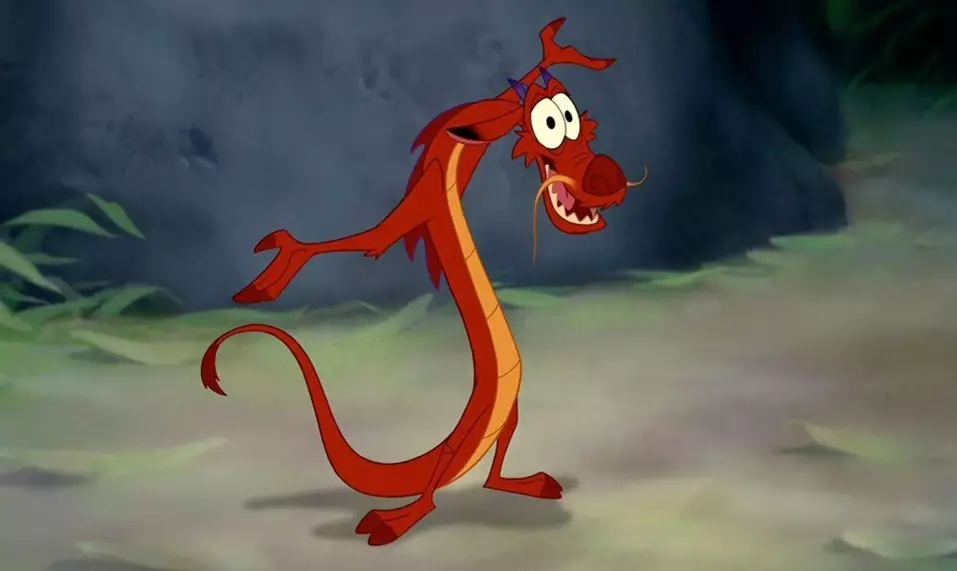
Fin Fang Foom in Marvel Comics
Debuting in 1961, Fin Fang Foom is an alien dragon resembling those of Chinese mythology. He has appeared in various comic storylines, often as an adversary to Iron Man. His character blends science fiction with traditional dragon lore.
“The Dragon Heroes” (2005)
This Chinese television series centers around dragons and their interactions with humans, weaving traditional myths into its narrative. The show explores themes of loyalty, love, and the enduring bond between dragons and humans.
“Shang-Chi and the Legend of the Ten Rings” (2021)
This Marvel Cinematic Universe film introduces the Great Protector, a benevolent water dragon that aids the protagonist in battle. The dragon’s design draws heavily from traditional Chinese depictions, emphasizing its cultural significance.

